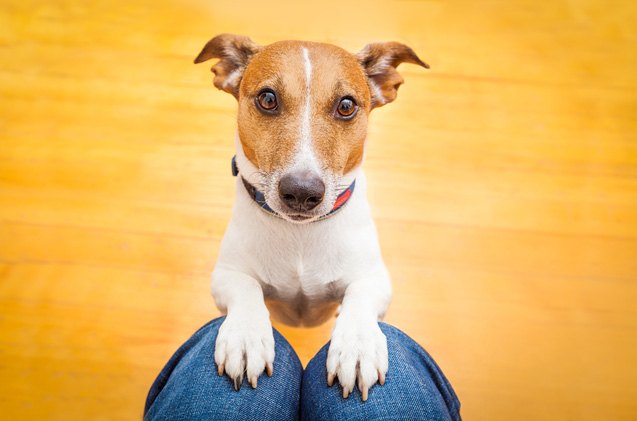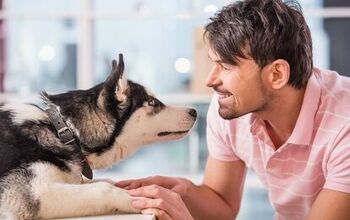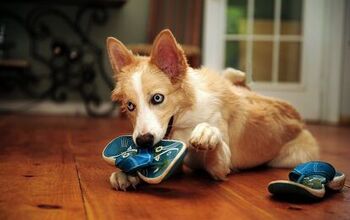10 Training Tips for Eager Greeters

When the doorbell rings, does it send your dog into a barking frenzy? Does he jump up on your guests as soon as they walk through the door? A friendly dog is a wonderful thing, but there comes a point when your dog’s friendliness can be too much. Here’s how to stop your dog from jumping up on and barking at your guests.
Additionally, an overly excited dog can lead to a dangerous situation. Your dog may accidentally knock guests over, especially children, or escape through the door during the excitement. This is why it is important to address this behaviour sooner rather than later, to keep everyone safe.
Related: 5 Tips to Keep Your Dog from Digging in the Yard
Teaching Your Dog Not to Bark at Guests
Many dogs have natural protective instincts that drive them to bark at anyone or anything that encroaches on their perceived territory. This can be a good thing if you are looking for a guard dog, but it can become a nuisance if your dog barks at the drop of a hat (especially if you live in close quarters such as a condo or apartment building). One of the most effective ways to stop your dog from barking at guests is to first teach him to bark on command and then teach him to stop barking on command. Here is a sample training sequence you might try:
- Have a friend or family member stand outside the front door of your house while you wait inside with your dog (have some treats on hand as well).
- Ask your friend to knock or ring the doorbell in order to get your dog excited enough to bark.
- As soon as your dog barks, mark the behavior by saying “Good” or using a clicker then reward him with a treat.
- Repeat this sequence a few times then start giving a verbal command before ringing the doorbell – something like “Speak” usually works well.
- Keep working with your dog, saying “Speak” just before ringing the doorbell and only rewarding him when he speaks on command.
Once your dog has gotten the hang of this training sequence you can adjust it to teach him to stop barking on command. Go through the training sequence as listed above but do not reward your dog for barking – instead, after you tell him “Good”, give him a “Hush” command. Wait for him to stop barking then say “Good” again and give him the treat. Repeat as necessary until your dog responds consistently to the “Speak” and the “’Hush” commands.
Related: Why Do Dogs Hump?
Teaching Your Do Not to Jump Up on Guests
Another problem many dog owners have with overly eager greeters is their dog’s habit of jumping up on guests or licking them. Many dogs develop this behavior because their owners unknowingly reinforce it when they are young and small. Here is a simple training sequence to remedy this problem:
- Have a friend or family member stand outside the front door of your house while you wait inside with your dog (have some treats on hand as well).
- Ask your friend to ring the doorbell and then enter the house, ready to respond as soon as the dog jumps up.
- When your dog jumps up, have your friend immediately turn around and ignore the dog, keeping his arms held close to his body.
- Wait for your dog to calm down and to stop jumping up then tell him “Good” and let your friend turn around and pet him calmly for a few seconds.
- Repeat this training sequence as needed until your dog gets the hang of it.
Related: Should I Train My Dog With A Clicker?
Using the Place Command to Allow Guests Through the Door
If your guests are trying to enter your home while your dog is overly excited about their arrival, he or she may create an uncomfortable or unwelcoming experience. Just the act of getting through the door can quickly become a challenge as your dog proceeds to jump on them, smell them all over, bark, give them kisses, or even tries to escape. Not only is this less than ideal for your guests, but it could also be dangerous if your dog were to get loose.
A simple command that can turn this whole situation around effectively is the ‘place’ command. The command instructs your dog to go to a specified place such as a blanket or dog bed and remain there until released. If you have guests knocking on your door, you can then send your dog to their ‘place’ before opening the door, giving everyone time to get in and close the door before giving your pup permission to come greet the visitors. Here is a simple training sequence to teach ‘place’:
- Select a dog mat, dog bed or blanket that you will be using as your dog’s designated place. Set it out and allow your dog to explore, praising and rewarding them with treats and/or the clicker anytime they show it any attention such as sniffing it. State ‘place’ just before rewarding each time to start introducing the command.
- Lure your dog onto the bed, rewarding them when they step onto it. Eventually, move to luring them into a down on the bed and offering a reward or click. Offer a ‘release’ right after rewarding them, giving them the okay to get up and leave the bed once again.
- Slowly add time between laying down on the mat and the release.
- When your dog is willing to stay, add distance between you and the mat when you give the command.
- Add distractions to your training such as other people moving in the room and, eventually, having a friend at the door when you give the command.
If you have already done basic training and taught the ‘down’ command, this whole process will go a lot smoother. If you have multiple dogs, train each dog separately without the other dog in the room so that they can focus on the command. You can bring the dogs together when you reach the stage of adding distractions.
This command can also be used if your dog starts to become overwhelming when your guests are in the house. For example, if your dog has a habit of getting up on the couch to sniff and kiss your guests after they have sat down, this is a great option. Simply send your dog to their place until they have calmed down.
Even if most of the people you have over to your house are dog lovers, not everyone likes to be attacked by a ball of friendly fur as soon as they walk through the door. A well-trained and well-behaved dog is a wonderful thing and, by utilizing the training tips provided above, you can make it a reality!

Kate Barrington is the loving owner of two cats (Bagel and Munchkin) and a noisy herd of guinea pigs. Having grown up with golden retrievers, Kate has a great deal of experience with dogs but labels herself a lover of all pets. Having received a Bachelor's degree in English, Kate has combined her love for pets and her passion for writing to create her own freelance writing business, specializing in the pet niche.
More by Kate Barrington























